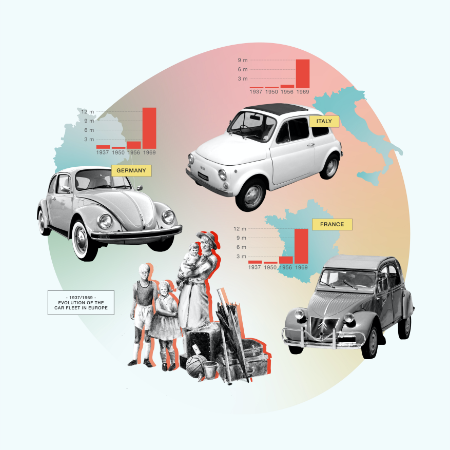A car that smacks of paint, women, speed
A Lancia Aurelia B24 and the cheeky face of Vittorio Gassman.
These two elements created the greatest advert for cars and, at the same time, for car insurance. We are, of course, talking about the film “Il Sorpasso”.
Everyone knows “Il Sorpasso” even if they’ve never seen it.
Two men in a beautiful convertible car on the roads of Italy, in the full splendour of the Italian summer.
The two men are Jean-Louis Trintignant and Vittorio Gassman himself, directed by the skilful hand of Dino Risi.
It doesn’t matter what they’re doing, it doesn’t even matter why they’re doing it, what matters is that they are in a splendid car, an Aurelia B24, and their expressions and the speed of the car suggest they are destined to conquer the world.
This is what happened in Italy, and even earlier in Germany and around the world, thanks to marketing of cars.
The car is a powerful and revolutionary vehicle that radically changed the habits and customs of both drivers and those watching them speeding by.
Initially, the legislation regarding the circulation of motor vehicles, which replaced horse-drawn carriages or railway carriages, was an unknown territory, to the point that it is difficult to make sense of it.
In Italy, the Public Automobile Register – generally known as “P.R.A.” – was created first, in 1927. Six years later, a summary set of rules was drawn up, but no real highway code existed until after the Second World War.
THE PRESIDENT OF THE REPUBLIC
Decrees:
Single article.
The single text of road traffic regulations, endorsed by the Ministers for Public Works and Transport, has been approved. It is the duty of everyone concerned to observe and enforce it.
Issued in Rome, 15th of June 1959 The President Giovanni GRONCHI
There were countless accidents, and no rules or regulations for damage to property and people.
Those who had the foresight to take out an insurance policy would be grateful for it, also in the event of dramatic accidents, as evidenced by letters sent to the Generali offices from the relatives of victims of road accidents, such as this one:
“Quarona, 25th November 1952”
Dear Assicurazioni Generali Venice,
We wish to express our sincere thanks for the truly exceptional solicitude with which you have settled the life and accident policies, issued for just one year on the life of our late Mr Mario Zignone, providing for the payment of the substantial sum insured with the two contracts only a short time before our father met his tragic end, due to a car accident.
(...)
With our highest esteem,
Luigi Zignone’s children.”
Scandinavia was the first region to introduce compulsory motor civil liability insurance, starting in 1918.
Italy only did so in 1971 with a real law, numbered 990.
And, five years later, the famous “European Accident Statement” report would be introduced – the document everyone keeps in the glove boxes of their cars with the hope of never having to fill it in.
Alas, that report would not help Vittorio Gassman when, at the wheel of his Lancia Aurelia B24, he made that dangerous and fatal overtaking.
HISTORY

In Italy, car insurance has been compulsory since 1971, the year in which law number 990 of 1969 entered into force, while in other European countries it was enforced much earlier.
In the atmosphere of waiting for the law to be passed, companies stood by, ready to adapt their structures to support the expected huge increase in workload that would inevitably result from making insurance coverage compulsory. Generali improved its recruitment and settlement services: the former with the increasingly widespread adoption of simple and immediate contractual tools, the latter by accelerating the definition of damages with faster and more adequate procedures.
